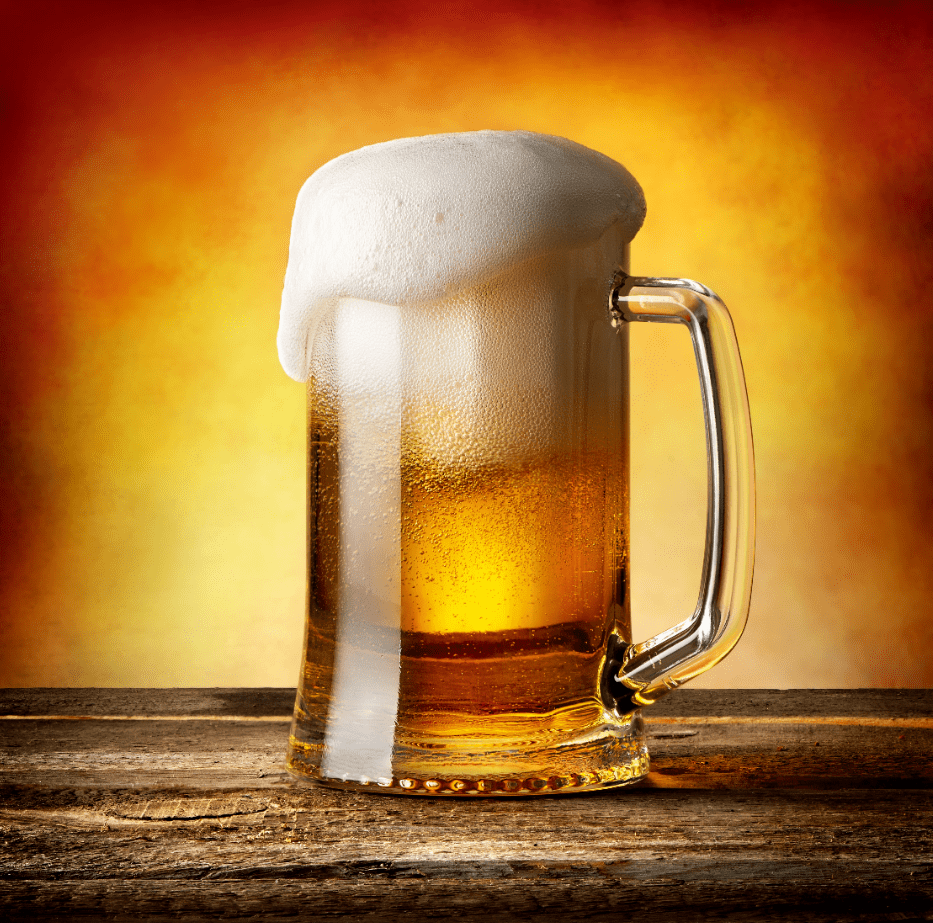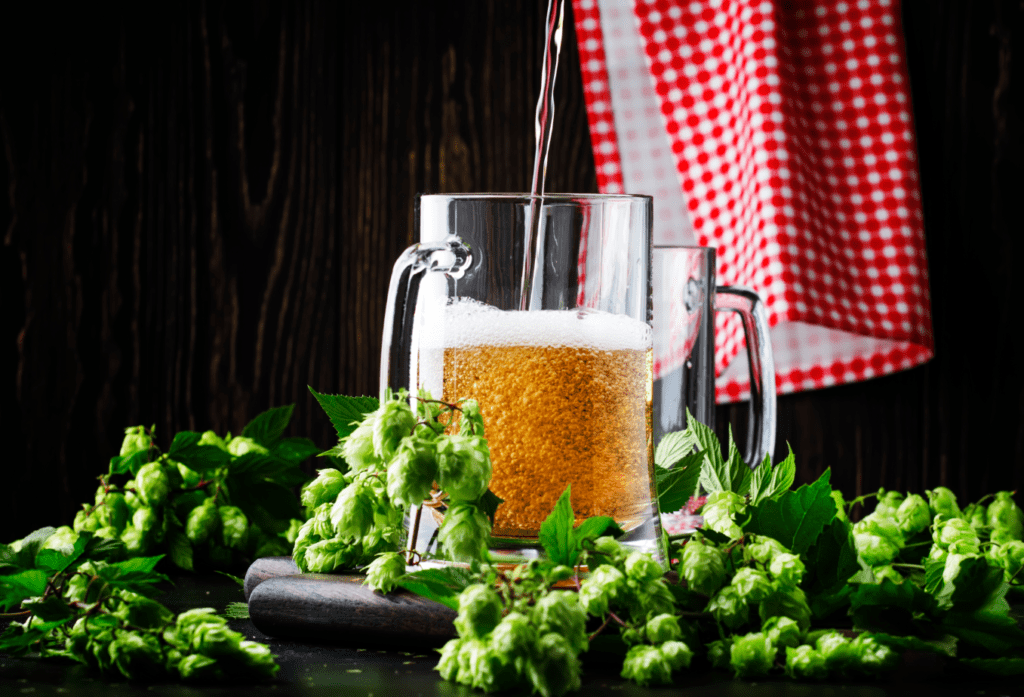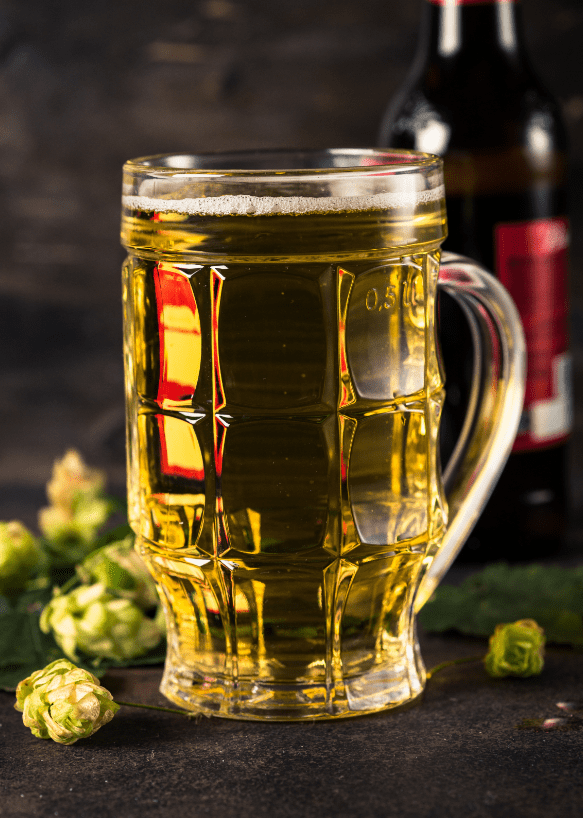History, Techniques, Ingredients and Recipes

A frothy white head, crystal clear pale yellow in color and a small army of bubbles cascading up the glass that invites you to take a first sip. A well made American pilsner can be the perfect beer to quench your thirst. Clean and crisp in taste, these beers keep you coming back for more.
American pilsner is a fairly wide category, it is not as focused nor as defined as German or Czech pilsner. It has also changed a lot over time, particularly around prohibition and the great depression. It includes the very light tasting present-day macro lagers that calls themselves pilsner, as well as the pre-prohibition style which is usually a fuller bodied and more bitter style. The ABV can vary and be lower or higher than the German examples, and the use of adjuncts (corn, and sometimes rice), which is entirely absent in the German or Czech versions, is commonplace in the American versions. And while you almost always see all-German ingredients in German pilsners, and all-Czech ingredients in Czech pilsners, the American pilsners often use ingredients from other countries like Mexico or Germany, in addition to domestic ingredients.
History
Early American pilsner beer was influenced heavily by German immigrants traveling to the US and bringing their techniques with. Early American pilsners were likely very similar to German pilsners. Over time, many American pilsners became closer to what you see in the macro lagers of today: lighter, lower hopped beers that are designed to appeal to a wider, more casual audience. Further influence can be seen from around the time of prohibition, when alcohol was banned and the focus was more about supplying a large amount of alcohol to as many people as easily as possible. There was also a shift around the Great Depression, when grain prices jumped and adjuncts, especially corn, became more attractive. Adjuncts like rice and corn further lightened these beers and separated them from their European counterparts. These influences can still be seen today in the many macro-lagers that bill themselves as pilsner and they have a lot of overlap in the American Light Lager style. But homebrewers and some smaller, high quality breweries alike are helping bring back quality American pilsner, made with high quality ingredients and filled with flavor, to rival the best European versions.
Ingredients and Techniques

Corn is a common ingredient in these beers, it was often used historically and was (and still is) a very affordable adjunct to add to a beer. You’ll see below that both Dan and Scott used corn in their recipes. It is more fermentable than malted barley, so it’ll help further attenuate and dry the beer out, though the corn contributes a sweetness that will partially offset that dryness and will provide a unique flavor addition to the beer.
You’ll also see rice is used as well. Like corn, rice is more fermentable than malted barley and will help dry out the beer, but with far less of a flavor contribution than corn. Most brewers that use rice in their American lagers are using typical white rice and are looking for very clean results. Less common, but worth looking at, is adding heirloom and other artisanal varieties of rice. Red rice, black rice, etc. You can find plenty of different types of rice at specialty grocery shops and online boutique food stores. Depending on what variety you choose, you might end up with nutty or floral notes in the final beer.
You can also approach an American pilsner from an all-malt perspective. This is my typical approach. With a good clean, well attenuated yeast, I find that my final beer will be dry enough and I really value the full body and mouthfeel that I can get from using all-grain in the grist and step mashing. American pilsner malt, 2 row or 6 row are all fair game here. Dashes of munich, vienna or even victory are not unheard of, they can lend a bit of maltiness to balance the more aggressively bittered versions of this style.
For hopping these beers, you’re looking more for earthy, floral, grassy and/or spicy contributions in flavor and aroma. You usually want to avoid citrus flavor forward hops. I like to look at hop varieties that are based on the noble hops of Germany. Mt Hood and Crystal (lineage from Hallertau Mittelfruh) are two American hops that are remarkably similar to some of the German noble hops. Other options include Hallertau, Tettnanger and Saaz varieties grown in the US, which will be similar, but distinctly different from their European cousins. Other low alpha acid varieties such as Willamette (derived from Fuggles), will lend a woody spice, Vanguard has some herbal spice and Liberty contributes light spice and floral notes. Sterling is another great selection for these beers too. German noble hops are often used as well, and unlike many country-specific styles, non American ingredients are perfectly acceptable and were widely used at times in American pilsner beers.
Single infusion or step mashes are common. I personally prefer the latter in my lager beers, it results in a slightly fuller body and mouthfeel with more, longer lasting foam, but you can have excellent results either way.
For yeast, you’re looking at clean lager yeast. Mexican lager strains or German lager strains are the standard here. You want a clean fermentation from the beer and a high final attenuation. Similar to Northern German pilsners, that dry, crisp finish is a classic telltale sign of the style.
There are many different techniques for fermenting these beers. You can go low and slow, starting in the 40F-50F range (dependent on your strain) and hold until fermentation is complete, usually 2-3 weeks. Then lower it for cold lagering near freezing for another 3-6 weeks. It’s also very popular to begin in the low 50s and slowly raise the temperature as fermentation is ongoing, eventually raising the temperature into the 60s for a diacetyl rest. Then cold crashing and lagering for 1-3 more weeks. You can warm lager ferment these in the low 60s as well, many homebrewers have had great success, especially when fermenting under pressure (Dan Moore makes his American pilsner recipe below at 10 PSI near room temperature). These beers are usually kegged and well carbonated to 2.5-2.8 volumes.
Recipes

I met both Scott Jackson and Dan Moore through my local beer club, KROC, years ago. Scott is a tremendous homebewer who has won dozens of medals over the years and published several articles as well. Dan brewed professionally as the head brewer of Nighthawk Brewery and helped turn that brewery around as far as the beer quality goes. He’s now producing beers at home and building a portfolio of primarily lager recipes, that he hopes to launch a lager-focused brewery with in the coming years. I’ve had a chance to taste his lagers, and they’re fantastic. He’s been experimenting with pressure fermentation at warmer temperatures and faster turnaround times and he’s had excellent results.
Note: The recipe software had limited fermentation profile customization. Therefore, you’ll see the recipe fermentation profile differs from the specifics of how the following authors ferment their beer. I added that fermentation information in the Notes section of each recipe.
Scott Jackson’s Uncle Andrews American Pilsner
This beer is named after a story that Scott’s grandfather would tell him about how they are related to Andrew Jackson. Scott says that they did live in the same area, so you never know! I’ve had this beer before and it’s an excellent beer. It is bittered similar to a Northern German pilsner with a touch of hop flavor from the end of the boil contribution, but it uses American grains, as well as both flaked corn and cooked rice. The rice helps dry it out a bit, as does the corn, which also lends a distinct sweetness to the beer.
Scott also silver medaled with this beer at NHC in the Pilsner category.
Recipe Details
Batch Size |
Boil Time |
IBU |
SRM |
Est. OG |
Est. FG |
ABV |
|---|---|---|---|---|---|---|
6 gal |
80 min |
36.6 IBUs |
3.6 SRM |
1.055 |
1.018 |
5.0 % |
Style Details
Name |
Cat. |
OG Range |
FG Range |
IBU |
SRM |
Carb |
ABV |
|---|---|---|---|---|---|---|---|
27 |
1.044 - 1.06 |
1.01 - 1.015 |
25 - 40 |
3 - 6 |
2.4 - 3 |
4.5 - 6 % |
Fermentables
Name |
Amount |
% |
|---|---|---|
Pale Malt (6 Row) US |
7.5 lbs |
71.43 |
Corn, Flaked |
1 lbs |
9.52 |
Munich I (Weyermann) |
1 lbs |
9.52 |
Store Bought Cooked Rice |
1 lbs |
9.52 |
Hops
Name |
Amount |
Time |
Use |
Form |
Alpha % |
|---|---|---|---|---|---|
Magnum |
1 oz |
75 min |
Boil |
Pellet |
11.5 |
Mt. Hood |
1 oz |
2 min |
Boil |
Pellet |
4.7 |
Yeast
Name |
Lab |
Attenuation |
Temperature |
|---|---|---|---|
Mexican Lager (WLP940) |
White Labs |
74% |
50°F - 55°F |
Mash
Step |
Temperature |
Time |
|---|---|---|
Protein Rest |
120°F |
5 min |
Saccharification |
158°F |
30 min |
Mash Out |
168°F |
10 min |
Beta Rest |
144°F |
30 min |
Fermentation
Step |
Time |
Temperature |
|---|---|---|
Primary |
14 days |
50°F |
Secondary |
0 days |
62°F |
Aging |
30 days |
34°F |
Notes
| Adjust your malt for your own brewhouse efficiency to hit 1.056 OG. Ferment at 50F for 2-3 weeks until fermentation is complete and final gravity has been reached. Then slowly lower it to 33F for 4-5 weeks of cold lagering. For the rice, Scott purchases regular long grain rice from the grocery store, cooks it then throws it in the mash. Scott mentions that he may leave the munich malt out during the next brew. |
Download
| Download this recipe's BeerXML file |
Dan Moore’s American Pilsner
Dan’s pilsner recipe that he shared with us is closer to what you’d expect to see from a macro US lager labeled a pilsner. But with fresh ingredients and a clean fermentation, this will be a high quality beer. There is just a little bit of hop bitterness to balance the beer here. The flaked corn and the malt are going to be the primary stars of the show. This will be a fairly light, very drinkable beer, and if you brew it in the summer it will almost certainly be gone fast.
Recipe Details
Batch Size |
Boil Time |
IBU |
SRM |
Est. OG |
Est. FG |
ABV |
|---|---|---|---|---|---|---|
5 gal |
60 min |
10.2 IBUs |
3.0 SRM |
1.047 |
1.008 |
5.1 % |
Style Details
Name |
Cat. |
OG Range |
FG Range |
IBU |
SRM |
Carb |
ABV |
|---|---|---|---|---|---|---|---|
1 B |
1.04 - 1.05 |
1.004 - 1.01 |
8 - 18 |
2 - 4 |
2.5 - 2.9 |
4.3 - 5.3 % |
Fermentables
Name |
Amount |
% |
|---|---|---|
Pale Malt (2 Row) US |
5 lbs |
56.5 |
Corn, Flaked |
1.75 lbs |
19.77 |
Pale Malt (6 Row) US |
1.75 lbs |
19.77 |
Dextrose (Briess) |
5.6 oz |
3.95 |
Hops
Name |
Amount |
Time |
Use |
Form |
Alpha % |
|---|---|---|---|---|---|
Perle, U.S. |
0.35 oz |
60 min |
Boil |
Pellet |
8.3 |
Yeast
Name |
Lab |
Attenuation |
Temperature |
|---|---|---|---|
Mexican Lager (WLP940) |
White Labs |
74% |
50°F - 55°F |
Mash
Step |
Temperature |
Time |
|---|---|---|
Mash In |
149°F |
75 min |
Fermentation
Step |
Time |
Temperature |
|---|---|---|
Primary |
14 days |
54°F |
Secondary |
3 days |
62°F |
Aging |
30 days |
60°F |
Notes
| Dan prefers WLP940 Mexican Lager yeast, pressure fermented @ 10PSI at or near room temperature. Or, without pressure, 34/70 dry yeast. |
Download
| Download this recipe's BeerXML file |
Ryan’s All-Malt American Pilsner
One of my favorite styles of beer is a German pilsner. So it should be no surprise that I like to model my American pilsner after the German varieties. I start with one of my German pilsner recipes, but I replace the malts with American pilsner malt varieties from local craft maltsters. We have several here in Colorado, such as Proximity, Root Shoot and Troubadour. There are craft maltsters across the country though. Find one that is in your state or region, you’ll be supporting your local economy, using ingredients from your terroir like they did practically everywhere in the world historically, and most of all you’ll be getting really fresh malt that will shine in your beer.
From there, I like to use local hops. My own town has a small hop farm called Voss Farm Hops. You can use homegrown hops as well, as long as they smell fresh. If you don’t want to pay to get an alpha acid test done, use your homegrown hops for flavor and bitter with a commercial version that has alpha acid information so you can dial in the bitterness levels.
I use an appropriate amount (usually 25-35g per 5 gallon batch) of 34/70 yeast. It’s really simple, it attenuates well and it is very clean. I ferment at low temps, starting in the high 40s, usually under pressure, and I use biofine towards the end of the cold lagering period. The result is a clean and inviting beer with that classic dry, crisp pilsner finish. It’s very similar to a Northern German pilsner, but it is distinctly American with flavors from my local ingredients.
Recipe Details
Batch Size |
Boil Time |
IBU |
SRM |
Est. OG |
Est. FG |
ABV |
|---|---|---|---|---|---|---|
5.3 gal |
75 min |
36.1 IBUs |
3.2 SRM |
1.049 |
1.012 |
4.8 % |
Style Details
Name |
Cat. |
OG Range |
FG Range |
IBU |
SRM |
Carb |
ABV |
|---|---|---|---|---|---|---|---|
27 |
1.044 - 1.06 |
1.01 - 1.015 |
25 - 40 |
3 - 6 |
2.4 - 3 |
4.5 - 6 % |
Fermentables
Name |
Amount |
% |
|---|---|---|
Pilsen (Proximity) |
9.5 lbs |
100 |
Hops
Name |
Amount |
Time |
Use |
Form |
Alpha % |
|---|---|---|---|---|---|
Mt. Hood |
1 oz |
60 min |
Boil |
Pellet |
6 |
Sterling |
0.5 oz |
30 min |
Boil |
Pellet |
7.5 |
Sterling |
0.5 oz |
5 min |
Boil |
Pellet |
7.5 |
Yeast
Name |
Lab |
Attenuation |
Temperature |
|---|---|---|---|
Saflager Lager (W-34/70) |
DCL/Fermentis |
83% |
48°F - 59°F |
Mash
Step |
Temperature |
Time |
|---|---|---|
Mash Step |
144°F |
40 min |
Mash Step |
160°F |
40 min |
Mash Step |
170°F |
10 min |
Fermentation
Step |
Time |
Temperature |
|---|---|---|
Primary |
14 days |
54°F |
Secondary |
3 days |
62°F |
Aging |
30 days |
60°F |
Notes
| I typically do 49F for 2-3 weeks until it reaches full attenuation (it should be closer to 1.10-1.12 with this yeast). Then I taste and make sure I don't get any buttery diacetyl (a diacetyl test, where you heat up a sample in the microwave to 100F+ and give it a good smell/taste, will make it pretty obvious). I slowly lower it down to near freezing and hold it for another 3-6 weeks, adding biofine to the keg during the last week. I like the dryness you get from using 100% pilsner malt, while retaining that full malt flavor. I would strongly urge step mashing for this recipe. If you want to do a variation on this beer, you can start by playing around with the hop varieties. Malt wise, you could add up to 20% corn and perhaps 3-5% of munich or 5-10% vienna malt. You could keep it 100% pilsner malt and do a single decoction as well. |
Download
| Download this recipe's BeerXML file |
Further Reading
This article is focused primarily on ingredients and recipes and only briefly touches on the history of these beers. There is a massive amount of information out there on the history of American pilsners and American lager beer in general. I’d recommend recent podcast guest Tom Acitelli’s Pilsner Book. Dave Carpenter’s Lager Book is a fantastic resource for every American style lager. There are also a variety of interesting history books that are often city specific. One example is on Cincinnati’s brewing history. These kinds of books are often written by historians who also happen to be beer fans and include a host of really neat old logos, newspaper ads and photos of American lager breweries.
